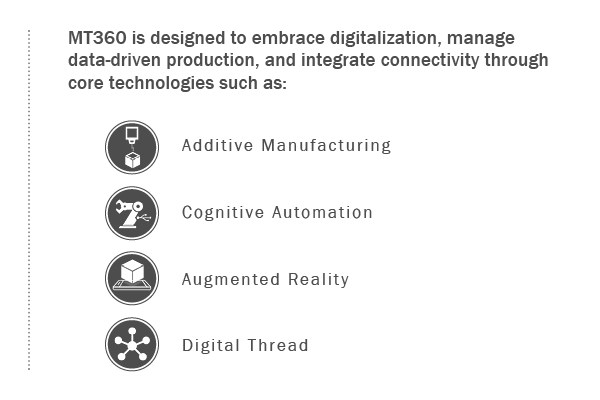Manufacturing Event Features Revolutions in Automation
Sponsored ContentThe MT360 event will feature Cognitive Automation, the use of AI and Machine Learning to improve the capabilities of automated systems.
Share
The goal of artificial intelligence (AI), despite what Hollywood movies tell you, is simply to accomplish complex tasks with minimal oversight. While existing automation systems — not just robots, but also pallet changers, bar feeders and other systems — are reliable to a point, programming these systems can be complicated. Moreover, a poorly defined command can easily lead to damaged equipment or scrapped parts.
The next step in automation is to eliminate the burden of programming actions the machines must perform, replacing this practice with an AI-integrated automation system capable of deciding how to best complete a defined objective on its own. Called Cognitive Automation, this approach to automation systems is a major focus of the MT360 event in Santa Clara, Calif., in May of 2020.
What is Cognitive Automation?

This question is, by far, the most common reaction to hearing the term. While the term seems esoteric, the idea behind it is firmly planted in the realm of practical applications. According to Tim Shinbara, vice president of technology for AMT – The Association For Manufacturing Technology – cognitive automation refers to any automated system that develops its own path to accomplish its goal. “For something to fall under the umbrella of cognitive automation,” says Shinbara, “it needs to be able to perform a defined task without needing the user to decide on the intermediate steps.” Instead, the user defines both an objective and the constraints that limit the automation system, and the program figures out on its own how to approach the task.
Essentially, rather than program each step in the process for a robotic arm, CNC machine or other automated system, cognitive automation uses a variety of technologies that enable the system to determine the path to a goal. Once the user sets the objective and limits, the system will work within those constraints.
For example, using artificial intelligence (AI), a CNC machine could use its measuring systems to determine whether it is within the defined acceptable range of the optimal material removal rate, making automatic adjustments to meet that criteria. Rather than just following an if/then sequence that resolves the issue, AI goes further. It can determine the root cause, then adjust the depth of cut, change out the cutting tool, or otherwise adjust the toolpath to reach the optimum rate.
Adaptability is the key strength of cognitive automation, according to Shinbara. “Anytime there is a disparity between the data you know and the data you need to know, combined with high volumes of tasks, cognitive automation can help.” Plant managers, discrete parts manufacturers and public works can all benefit from this, whether using machine learning to improve scheduling for jobs or deliveries, using sensor data to perform predictive maintenance, or using a combination of technologies to enable robots and autonomous vehicles to adapt to dynamic environments.
Cognitive automation will be on display at the MT360 event, May 12-14, 2020, where it will be one of the four technologies that make up the focus of the show:
- Additive Manufacturing – Manufacturing using 3D-printing technology, which is now achieving full production of complex parts.
- Augmented Reality – Technology that uses digital displays to assist with manual tasks.
- Cognitive Automation – Using AI to create automated solutions that are reactive to changing conditions.
- Digital Thread – Electronic connections that allow manufacturing information to follow a part through the entire production process.

MT360 features a range of technologies that provide practical manufacturing solutions.
According to AMT, these transformative technologies represent not just new ways of approaching challenges, but fundamental changes to how manufacturers will approach day-to-day tasks. In the case of cognitive automation, Shinbara says, “This technology is about more than improving the efficiency of automation. Using techniques like AI and machine learning, manufacturers can drastically expand what can be automated and to what degree.” To explore the capabilities of cognitive automation, AMT has joined with many technology partners for MT360.
Connecting Industry 4.0 to Automation for Manufacturing
Mazak will display solutions using iSmart Factory, the company’s Industry 4.0 solution for CNC machine shops. The system draws a wide range of information from as much equipment in a manufacturing plant as possible, from the machine tools to the HVAC, to identify problems in the manufacturing process.
The goal, says Mazak Plant Manager Kevin Sekerak, is predictive maintenance. “To improve something, you must first measure, then analyze and finally predict.” Once the system has analyzed enough data from a factory’s machines, it can not only identify developing problems before they affect the production line, but even start addressing those problems in some cases. Essentially, with iSmart Factory, Mazak hopes to automate parts of the maintenance process using data analysis. “Mazak is a working research and manufacturing facility,” Sekerak says. “It is dedicated to improving what is possible for systems to achieve.”

At MT360, Mazak will be demonstrating iSmart Factory solutions at one of the tech garage showcases. The Tech Garage is a key feature of the event, featuring practical solutions that incorporate multiple technologies working in tandem to overcome practical manufacturing challenges. These displays will be demonstrating each of the four major technologies that serve as the focus of the event, showing case studies to spark ideas in the attendees.
“MT360 is designed for the tech leaders in manufacturing, bringing them together with software companies and venture-capital firms to explore these new technologies together,” says AMT President Doug Woods. “Historically, there has been a gulf between these groups, and we want this event to serve as a hub for bridging that gap. All three groups will greatly benefit from seeing these technologies come to fruition, and we want to show them the path forward.” The tech garages are designed to show how these different companies can all benefit from investing in the transformative technologies on display.
Intelligent Technology that Drives Automation
According to Stephan Biller, Vice President and Chief Innovation Officer at IBM Watson, “True AI is set apart because it learns.” According to Biller, this is the capability that enables artificial intelligence to approach complex problems flexibly. Unlike a rule-based system, a learning system can analyze its behavior and adjust to improve the results. “As a system accumulates data, the true AI improves,” he says. “Event logs enable it to identify what works and what does not. The AI can look at past data and identify the events that precipitate a machine failure, alerting maintenance of the problem and suggesting solutions.”
“For something to fall under the umbrella of cognitive automation, it needs to be able to perform a defined task without needing the user to decide on the intermediate steps.”
Biller says that IBM’s Maximo system is capable of that and more, as it can not only identify problems and likely solutions, but it can also analyze employee credentials and history, making suggestions for who to assign to the maintenance request not only based on who has the necessary experience, but also on who needs the training to continue improving. Rather than replacing human capital, Biller says, this approach to automation helps the employees to grow and flourish.
To IBM, the technician of the future improves through automation, the factory of the future identifies failures before they occur, and the factory of the future brings in data from every available source. IBM is participating at MT360 because it enables the company to demonstrate the practicality of its products.

To be successful, cognitive automation solutions must also incorporate technology that enables flexible approaches to solving problems. Autonomous vehicles, for example, need to be able to sense obstacles in order to safely navigate a plant, which is where Humatics comes in. Humatics is the developer of a micro-location software based on ultra-wide band radio frequency technology. Essentially, this low-frequency radar can determine the locations of people and objects within a plant at a precision of 2 cm, then transmit those locations to a central hub. This enables autonomous vehicles to adapt to the changing circumstances of a plant floor, avoiding collisions and locating objectives easily. According to Humatics Vice President of Sales Phil Mann, “We’re participating in MT360 because we feel our technology provides and adaptive automation solution unlike what has come before.”
Technology that is redefining the norm is at the heart of MT360. AMT has set the stage to cross the historic divide between manufacturers, big tech companies, and technologies. Cognitive automation shows just how blurred the line between them has become. Moving forward, companies will need to understand both the practical needs of manufacturers and the technical capabilities of the AI-assisted technologies that will change the nature of their business.
Register for MT360 today.

